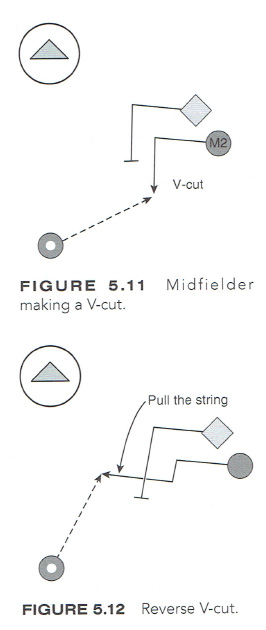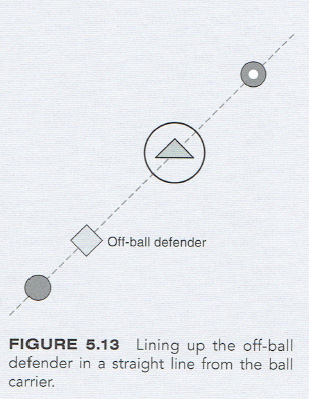|
By: Don Zimmerman and Peter England Originally Published in: Men's Lacrosse Provided by: Human Kinetics Ball exchange is another offensive maneuver that involves one player who has the ball and a second player who is off the ball. A ball exchange is a pass between two teammates. A pass connotes both intent and target. A pass is not a shot. Its velocity is moderated so that the catcher can handle the pass. A pass needs to be on target in order to secure a successful ball exchange. Lacrosse is a running game. If you're standing still when you throw or catch the ball, a defender will likely be able to disrupt the process with his body or stick. If you have defensive pressure, you need to cut or move in order to throw or catch the ball (you don't always have to cut for a shot). Ball exchange depends on your feet and your hands, not only to free yourself from your defender, but also to ensure a solid connection between the thrower and the catcher. Ball exchange involves principles of dodging and cutting: change of speed, change of direction, and deception.
If the thrower is running until he throws and the catcher is running until he catches, the pass will typically be a lead pass to the outside. When passing, you should always lead your teammate to the outside, away from defensive pressure. It's similar to a quarterback throwing a lead pass to a pass receiver toward the sideline and away from the defensive pressure. If the thrower misses his target, he wants to "miss wide" as opposed to handcuffing the catcher. The catcher can handle a wide pass better than one that handcuffs him. He can reach out to catch a wide pass, but a pass to his waist renders his hands ineffective. The primary technique for getting yourself open on a ball exchange is a V-cut. A V-cut is only necessary when there is defensive pressure. You drive your defender toward the goal, and your defender must give ground. When your defender is backing up, you pull away from him - that's what gives you separation or space so your hands are free to throw or catch the ball. It's similar to when a pass receiver sprints and drives the cornerback back so he has to give ground. The pass receiver separates from the cornerback and then comes back for the ball. For the V-cut, the angle is at 45 degrees because this opens up the passing lane and shortens the pass. If you make a V-cut and come back for the ball, the defender can't get into the passing lane. For example, assume midfielder 1 has the ball at field location 5, and midfielder 2 is located at field location 3 (see figure 10.1 for details about these field positions). Both are stationary, and they have a 20-yard pass between them. Midfielder 2 makes a 45-degree V-cut to the cage and back out. What was a 20-yard pass is now a 10-yard pass from midfielder 1 to midfielder 2. See figure 5.11 for an example making a V-cut. of this V-cut. On the other hand, if you use a straight cut, then the pass is longer, and the defenders can step into the passing lane. A V-cut tends to shorten the pass between teammates, and shorter passes usually have a higher percentage of completions. When you execute a V-cut, you should usually step to the ball right before you catch it. Some coaches teach players to do a 45-degree cut and then let the ball come to them. If you can't step to the ball, you need to adjust your body to the ball. In some instances, you may make a V-cut, and your defender will overplay you. In this case, you should do a reverse V-cut (see figure 5.12). You break off as if you're going to get the ball, encouraging your defender to overplay you, and then you cut backdoor. The purpose of the backdoor move is to keep your defender "honest." Off-ball offensive play involves various skills such as cutting, using a pick, ball exchange, and off-ball movement. Players may use cutting to create space, to catch a pass from a teammate, or to receive a feed for a scoring opportunity. Setting and using a pick are important skills. A pick is a major offensive weapon. Picks can be used anywhere on the field to get a player open for a pass, feed, or shot. A V-cut is the most effective tactic for achieving a successful ball exchange when a player is under defensive pressure. Off-ball movement is based on the straight-line principle. The offensive player is forcing his defender to either watch the ball or watch him. By using proper off-ball movement, you can set yourself up to execute a cut, pick, or ball However, in a man-advantage situation (e.g., 6v5) or if the opposing team is using a zone defense, the straight-line rule does not apply. In a zone defense, defenders are more focused on the ball than on a specific offensive player because each defender is really playing two attackers. If it's 6v6 and the opposing team is playing man-to-man defense, then the straight-line rule does apply. |




 exchange. Off-ball movement involves using your legs to get your stick in the right position to cut, pick, or exchange the ball. Off-ball movement is one of the most difficult things to teach and learn in offensive lacrosse. Young players tend to stare at the ball on offense, and they have no idea what's going on away from the ball. Off-ball defenders are taught to "V-up" on you so that they can see you and the ball. In contrast, you want to position yourself so that your defender is in a straight line between you and the ball (see figure 5.13). You should keep your head on a swivel so you can follow this rule: "Big eye on your man, little eye on the ball." Your primary focus is reading your man, and your secondary focus is watching the ball. You read your defender by watching his eyes, head, and body movements. If your defender makes a defensive mistake, the only way you will know about it is if you watch him. If you continue to adjust your position ("occupy your man") so that the defender is in a straight line between you and the ball, this forces the defender to make a decision. He can either watch you or the ball. If the defender chooses to focus on you, he will not be an effective team defense player because he will not be able to effectively slide. If he chooses to focus on the ball, you need to be a threat to score. You want to be close enough to him so that if he makes a mistake and "ball watches," you can cut and be dangerous and open in three steps.
exchange. Off-ball movement involves using your legs to get your stick in the right position to cut, pick, or exchange the ball. Off-ball movement is one of the most difficult things to teach and learn in offensive lacrosse. Young players tend to stare at the ball on offense, and they have no idea what's going on away from the ball. Off-ball defenders are taught to "V-up" on you so that they can see you and the ball. In contrast, you want to position yourself so that your defender is in a straight line between you and the ball (see figure 5.13). You should keep your head on a swivel so you can follow this rule: "Big eye on your man, little eye on the ball." Your primary focus is reading your man, and your secondary focus is watching the ball. You read your defender by watching his eyes, head, and body movements. If your defender makes a defensive mistake, the only way you will know about it is if you watch him. If you continue to adjust your position ("occupy your man") so that the defender is in a straight line between you and the ball, this forces the defender to make a decision. He can either watch you or the ball. If the defender chooses to focus on you, he will not be an effective team defense player because he will not be able to effectively slide. If he chooses to focus on the ball, you need to be a threat to score. You want to be close enough to him so that if he makes a mistake and "ball watches," you can cut and be dangerous and open in three steps.


